Written by Karen McGeachy – West
July 2023
2-3 minutes Read
What is Mini2P?
Mini2P was developed by the Kavli Institute for Systems Neuroscience (The Mini2P – The Kavli Institute for Systems Neuroscience – NTNU). It is an open-source miniature two-photon microscope which is designed for high resolution and fast calcium imaging in freely moving animals. The aim is to allow stable and high-quality imaging to be observed during a wide spectrum of behaviours without impacting the animal’s natural behaviour.
In comparison to a standard benchtop two-photon system which restricts the animal’s movement, the Mini2P miniscope is extremely compact and weighs less than 3 grams, so this allows easy and free movement of the animal. It is important to capture the animal’s natural behaviour, as it gives an accurate representation and insight into neural activities.
What current challenges does it face?
It is a fabulous open-source project which will allow a lot more users to access this technology and enhance their research. However, as with all open-source microscopy projects (such as open-SPIM), there are some challenges associated with it.
In particular, the building of the system may be quite difficult and time consuming for users, especially if they have no prior experience in this area. A complete system is made up of several parts, including:
- Femtosecond laser
- Fibre coupling to the laser – often via a coupling box which includes up to 4 glass rods to precompensate for GDD variations caused by the fibre. (Figure 1)
- An array of optics and further equipment to collimate and couple the fibre to the miniscope
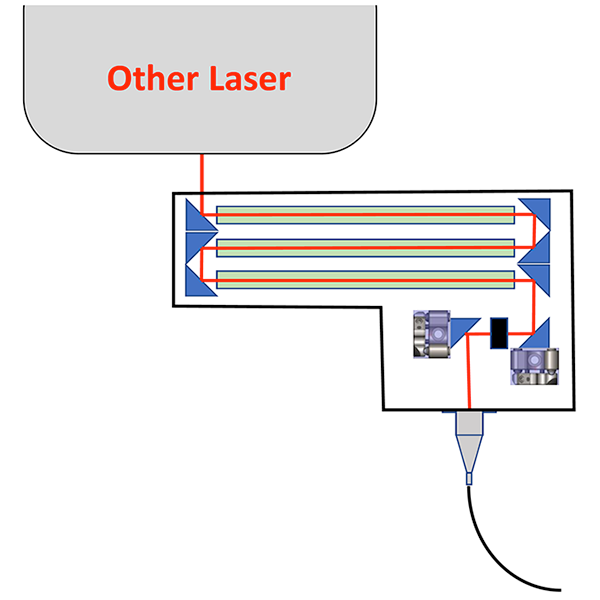
As you can see from Mini2P_toolbox on Github there is quite a lot involved in building the coupling box, assembling the HC-920 fibre, and many more aspects.
The fibre needed to connect the femtosecond laser to the miniscope can be quite fragile and requires delicate preparation.
This requires equipment such as that shown in Figure 2, below:
- Fibre cleaning accessories, as the fibre is susceptible to dust.
- Power meter to ensure a good coupling efficiency is achieved.
- Sheath cutters and glue to attach the fibre to the collimator system.
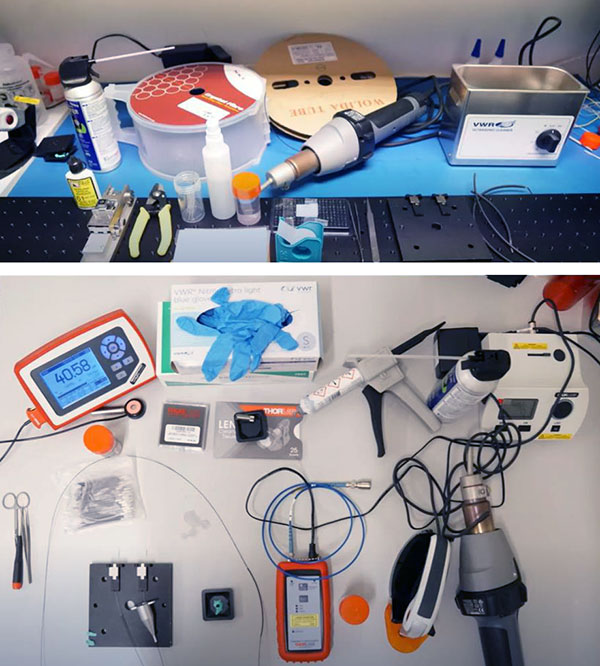
Fibre coupling and attaching to the collimator is not a trivial task and takes a lot of skill, time, and patience. As the fibre is glued into place, it also becomes difficult to replace should it become damaged in the future.
Another potential issue is that the coupling box is sensitive to vibration and temperature change so needs to be situated on a vibration free breadboard.
How does SPARK LASERS help overcome these challenges?
SPARK LASERS has been integrating the HC-920 fibre industrially into their FLeX fibre coupling option for their lasers for over 3 years. During this time, it has built up extensive expertise in both this particular fibre’s properties and also in fibre integration and fibre coupling. The company has used this expertise to simplify Mini2P integration into laboratories by offering the following:
A turn-key fibre solution which can be directly plugged into the miniscope via a collimator (Figure 3).
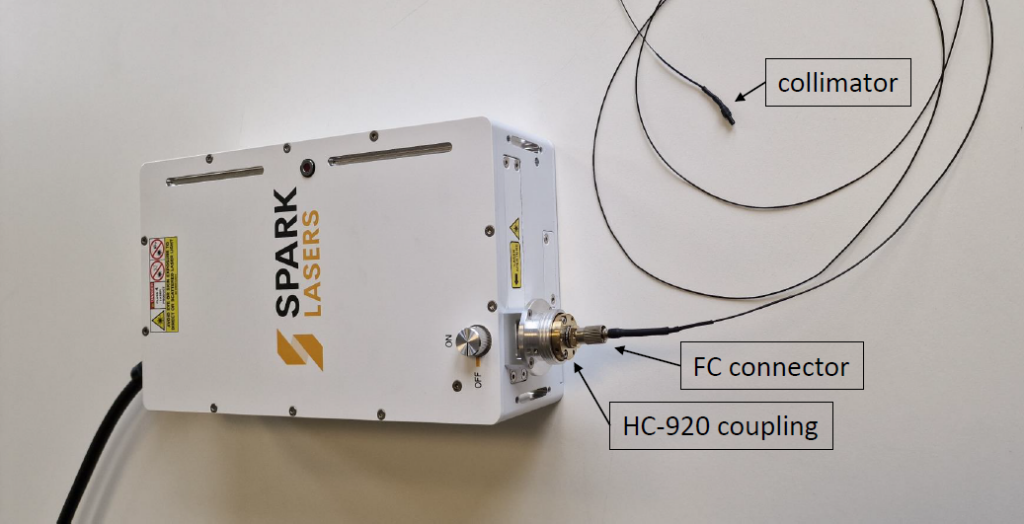
How this has been achieved:
- No coupling box and glass rods required. (Figure 4)
- Due to the large precompensation GDD that is offered with the laser (up to and beyond +120000fs2), there is no longer a need for a coupling box with glass rods as precompensation for the fibre as the laser can correct for this itself.
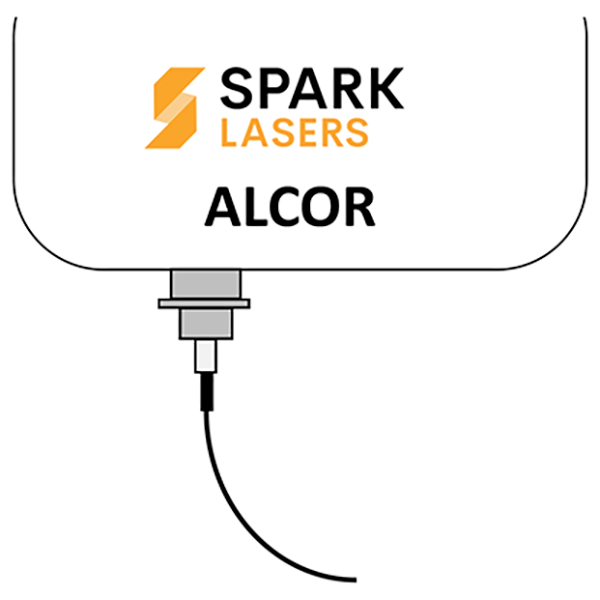
- Fibre coupling directly to the laser removes the need for alignment.
- As there is no need for glass rods, the laser can be coupled directly to the laser head in house at the factory. This negates the need for the user to couple a free space laser through the coupling box and then into a fibre, which is time consuming and non-trivial to do.
- No vibration-free breadboard required.
- Due to SPARK LASERS’ extensive fibre coupling knowledge, it optimises M2, polarisation extinction ratio, and stability vs temperature so the system is not sensitive to vibration and temperature changes.
- Simple fibre replacement should the fibre become damaged. (Figure 4)
- SPARK LASERS has designed the system to incorporate a rotating half-wave plate in the coupling unit, which is locked with a single screw. Therefore, the user can easily change the fibre should it become damaged during experimentation. A protective cone is also offered, that can be easily removed to help protect the fibre.
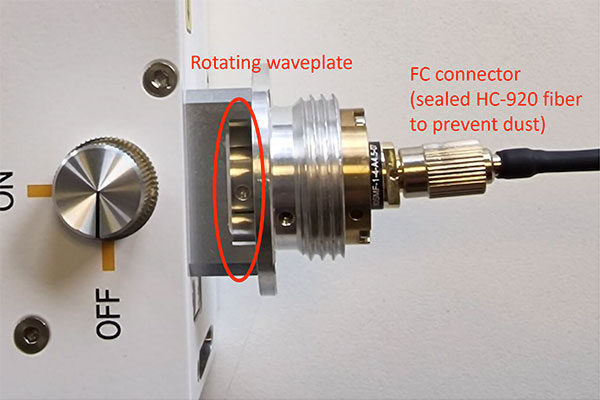
Summary
Hopefully this has shown that our partner SPARK LASERS has worked to provide the ideal source for Mini2P, by offering:
- Turn-key laser with HC920 fibre, including the collimator and optimal coupling efficiency.
- The remarkable positive GDD precompensation, which suppresses the need for a coupling box and glass rods.
- Unique innovative accessories, such as multibeam modules, to achieve parallel experiments.
We hope you will agree that these will help to simplify and elevate your Mini2P experiments.































